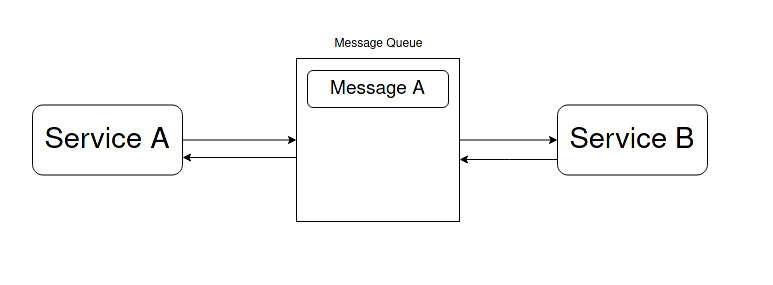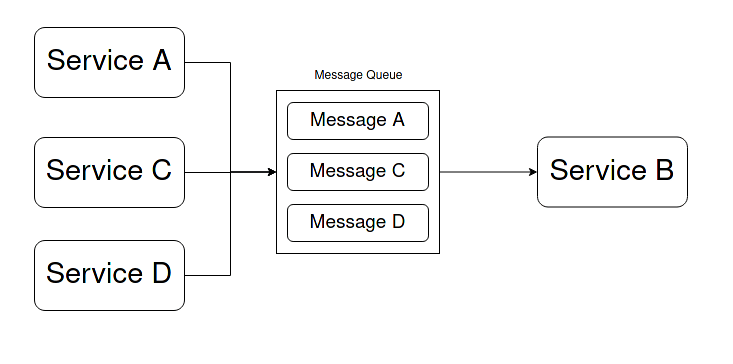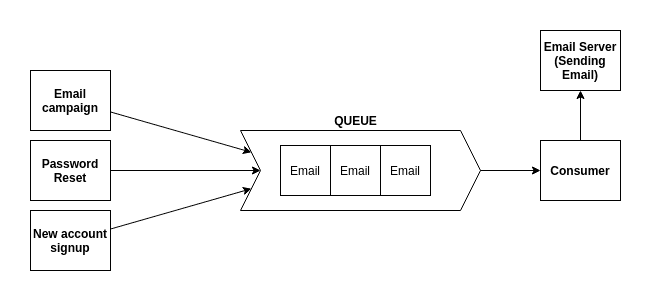Communication is key in both human interactions and applications. Applications often send and receive service requests via messages, which are processed and stored in Message Queues. These queues allow different systems to communicate reliably and asynchronously, enabling scalability and load balancing.
In this guide, we’ll cover the basics of Message Queuing Systems, such as asynchronous communication, decoupling applications, and load balancing. We’ll explore popular tools like RabbitMQ, Apache Kafka, and IronMQ, and explain their benefits, types, protocols, and a simple use case. Let’s start by defining what Message Queues are.
Table of Contents
What Are Message Queues?
To understand Message Queues, let’s break it down word by word.
Message: A communication sent by the sender (producer application) to the receiver (consumer application). A message is usually a byte array with some meta-data. It can be plain text, a status code, or a command. It consists of two parts:
- Header: The header provides information about the transmitted data; that is its meta-data.
- Body: The body describes the data to be communicated.
Queue: A line of messages waiting to be processed in sequential order. Typically, this order is based on First-In-First-Out (FIFO) principle, which means messages that arrive first are processed first.
Stitching our definitions together, a Message Queue is a system that stores and transmits messages for processing, ensuring they are received in the exact order they were sent (FIFO). It decouples the sending and receiving of messages, allowing communication between sender and receiver without needing both to be online at the same time. This asynchronous communication ensures messages are stored until the receiver is ready, and if delivery fails, they are rescheduled for later. Messages remain in the queue until successfully processed and acknowledged.
Why Does Asynchronous Communication Matter?
At this point, you might ask: Why does asynchronous communication matter? Or you might wonder what benefit does it serve me?
Using asynchronous communication in Message Queues, applications can work asynchronously. This assures three benefits:
- Zero data loss.
- Systems can continue to function if processes or connections fail.
- Higher throughput and scalability.
The adoption of asynchronous communication allows developers to keep processes and applications separate. Your sender and receiver applications are decoupled, meaning that sender and receiver applications get to work autonomously at separate times.
Asynchronous communication also improves reliability and scalability in communication between applications and services because messages are now processed in parallel, and at separate times. In such systems, the sender does not have to wait for a response from the receiver and, therefore, can proceed with other tasks.
Hevo Data, a No-code Data Pipeline Product can help you Extract, Transform, and Load data from a plethora of Data Sources to a Data Warehouse of your choice — without having to write a single line of code. Hevo offers an auto-schema mapper that automates the process of migrating, loading, or integrating from 150+ Data Connectors (including 60+ free sources).
Try Hevo and join a growing community of 2000+ data professionals who rely on us for seamless and efficient migrations.
Get Started with Hevo for FreeComponents & Concepts In Message Queues
A simple framework of Message Queues consists of Producers, Consumers, Messages, Message Queues, and Message Brokers. Let’s find out more about these:
1. Producer: Application or service that sends the message. A producer creates and publishes the message to the Message Queue using an asynchronous communication protocol.
2. Consumer: Application or service that receives the message. A consumer connects to the Message Queue to read and process the messages sequentially as are arranged in the Message Queue. Once received, a consumer sends an “acknowledgment” so that message can be deleted from the queue.
3. Message Broker: Software that allows applications, systems, and services to communicate and exchange data. A Message Broker can perform a range of operations on data like validation, transformation, aggregation, decomposition, rerouting, storage, and guaranteed delivery. Some prominent examples of Message Brokers include RabbitMQ, Apache Kafka, Redis, Amazon SQS, IBM MQ, and IronMQ.
Find in-depth information about Message Brokers in this all-inclusive guide here – Message Brokers: Key Models, Use Cases & Tools Simplified 101.
4. Message Translator: A Message Translator translates data from one format to another.
5. Load Balancing: Load balancing allows multiple users to read from a Message Queue at the same time. It also enables senders and receivers to send and receive messages at different rates.
6. Transactions: Transactions allow users to perform multiple operations. For example, using Transactions, a user can obtain a message from a Queue, and post the results of processing to a set of different query(s).
7. AMQP: Just like an HTTPS protocol for the web, Message Queues have their own protocol called Advanced Message Queue Protocol (AMQP). AMQP is an Open Standard Application Layer Protocol (ISO/IEC) that provides message orientation, queuing, routing, reliability and security.
What Are the Benefits of Using Message Queues?
Message Queuing is a great framework for ensuring no loss of data, reduced dependencies between applications, and increased data reliability. This section will go through all of the advantages in detail.
Better Coordination and Communication
The days of monolithic architecture saw applications/services that were tightly coupled. This meant that after dispatching the message, the sender would wait for the receiver application to process the message and send back a response.

However, our present-day needs are more immediate. We require efficient utilization of available resources without any delays. Message Queues solve this dependency bottleneck by decoupling applications, and immediately alerting the application/service after the message has been received/processed so that they can resume other tasks.
When the Message Queue receives a message from the sender application, it sends a response stating that the message request was received successfully. The receiver application/service then processes the message based on its availability and after its processing, the Message Queue pops the request out of the queue. This eliminates message redundancy by establishing a process that reads the message, confirms that it completed the transaction, and then removes it from the queue.

In addition, if something goes wrong in this framework, the message will not be lost. It will be rescheduled to be processed later.
Scalability and Improved Spike Handling
Asynchronous communication and decoupling of applications fabricate a scalable-ready architecture. Message Queues are easily scalable to handle numerous producers and consumers. Using this design, Message Queues can easily manage data spikes, ensuring that the data is persisted and handled, if not immediately, then later.

Higher Performance
Message Queues allow your sender apps to free up their bandwidth after delivering messages, while your consumer applications may always process new incoming messages. Because these operations may operate in the background and do not clog the system, performance is increased.
Best Deployment in Microservice Architecture
The microservice architecture includes applications that are interdependent, which means that no one service can complete its functions without assistance from others. This is where your system must have a mechanism in place that allows services to communicate with one another without being stopped by the constraints of dependencies or replies.
Message Queuing serves the best deployment for microservice architecture by allowing applications/services to asynchronously push messages to a queue and ensure that they are delivered to the proper destination.
Easy Monitoring
Oftentimes, the underlying processes working for message delivery are unfathomable or hidden from the users. With Message Queuing systems you get to keep track of your message transmissions processes like the number of messages in a queue, the rate at which messages are processed, and other statistics. This may be quite useful for application monitoring since it shows you how data flows through your system and if it is being backed up.
Improved Developer Productivity & Deployment Time
Developers may use Message Queuing Systems to create distinct components separately without needing to coordinate them. They may add new features, handle merge conflicts, and add codebases with a separate deployment pipeline, hence reducing the build and deployment time, and improving productivity.
Types of Message Queues
In this section of Message Queuing Systems, we discuss the two types of Message Queues: Point-to-Point and Publish/Subscribe.
Point-to-Point
Point-to-Point or P2P messaging model delivers one message to only one consumer application. There may be multiple receiver applications attached to the Message Queue, but each message in the queue is only consumed by one receiver application to which it is addressed.
To understand it better, have a look at the image given below. Here we have a Sender application, which creates a message “Message A” directed to Receiver 1. The message gets sent through the Message Queue and gets delivered to only one receiver.
In P2P, the sender and receiver applications have no timing dependencies. The receiver can fetch the message regardless of whether it was running when the sender application sent it. Once it’s successfully received, the receiver acknowledges the successful processing of a message to the Message Queue so that it can be removed from the queue.
Publish/Subscribe
A Publish/Subscribe messaging model, also pronounced Pub/Sub, delivers messages to all subscribers that are subscribed to that Topic. In Pub/Sub, message producers are known as Producers, and message consumers are called Subscribers, and the message mediation happens through Topics. Topics are essentially entities that contain the message and additional details like publisher and subscriber information.
Compared to P2P messaging, Pub/Sub can deliver a single message to multiple subscribers. All subscribers subscribed to that topic will receive messages and consume them. Another difference comes from the fact that P2P messaging requires the sender application to know the address of the receiver application. In Pub/Sub, the producer doesn’t need to know about the subscribers. This characteristic provides high decoupling for applications.
How to Communicate Using Message Queues
Message Queue is a linked list of messages stored within the kernel and identified with a unique key called Message Queue Identifier. To perform communication using Message Queues, you can refer to the steps described below:
Step 1: Create a new Message Queue or connect to one that already exists using msgget(). The msgget() function returns the Message Queue Identifier associated with the argument key.
Step 2: Insert a message into the queue using msgsnd(). Every message that is added to a queue, has a positive long integer type field, a non-negative length, and the actual data bytes (corresponding to the length), which are all supplied to msgsnd().
Step 3: Read a message from the queue using msgrcv(). Each message has an identifier so that the user process can detect and select the desired message.
Step 4: Execute Message Queue Control Operations using msgctl().
Message Queue: A Simple Use Case of Sending Emails
Companies use email services for a variety of purposes – gain customer signups, run marketing campaigns, deliver their weekly/monthly product updates to their customers, customer account reset, and so on. A careful examination of these actions reveals that none of them need urgent processing. Delays in email delivery are acceptable and do not interfere with the essential operation of the applications that use emails for various reasons.
Using Message Queues, for example, a company can run:
- Multiple producer services like marketing campaigns, account reset, product updates, and newsletters using formattable email elements into the queue.
- A single consumer microservice dedicated to email delivery functions and totally independent of the source of the email. This service can read messages from the queue one at a time and send emails accordingly.
- Scalable architecture that scales horizontally to include various customer email service instances that may listen to the same queue.

Conclusion
We hope this article has provided you with a clear knowledge of Message Queues, their types, advantages, and the procedure for using them. Message Queue Systems can greatly improve the performance of software applications or microservice architecture using application decoupling and asynchronous communication that harmonize to deliver scalability, data reliability, and reduced dependency.
For ETL starters, crafting an in-house solution can be a daunting task. Third-party ETL tools like Hevo Data reduce time to deployment significantly from months and years to minutes. Our No-Code Automation Platform offers more than 150+ SaaS Connectors to readily transfer data from your frequently used applications into a centralized repository like a Data Warehouse.
The best part about Hevo is that setting up Data Pipelines is a cakewalk; select your source, provide credentials and choose your target destination; and you are done.
Visit our Website to Explore HevoHevo can connect your frequently used applications to Data Warehouses like Amazon Redshift, Snowflake, Google BigQuery, Firebolt, or even Database Destinations like PostgreSQL, MySQL, or MS SQL Server in a matter of minutes. Matter of fact, you need no extensive training to use our ETL solution.
SIGN UP for a 14-day free trial and experience the feature-rich Hevo suite first hand. You can also have a look at the unbeatable pricing that will help you choose the right plan for your business needs.
Have any questions on Message Queue? Do let us know in the comment section below. We’d be happy to help.
FAQs
1. What are message queues used for?
Message queues are used to enable asynchronous communication between different applications or components by temporarily storing messages until they can be processed. They help decouple systems, improve scalability, manage workloads efficiently, and ensure reliable message delivery even during failures or high traffic.
2. What is an example of a Message Queuing system?
An example of a Message Queuing system is RabbitMQ, which implements the Advanced Message Queuing Protocol (AMQP). It allows applications to communicate asynchronously by sending and receiving messages through queues, ensuring reliable message delivery and decoupling of components.
3. What is a queued message?
A queued message is a message that is temporarily stored in a message queue until the recipient application is ready to process it. It ensures reliable, asynchronous communication between components by holding messages in sequence until they are successfully received and processed.



